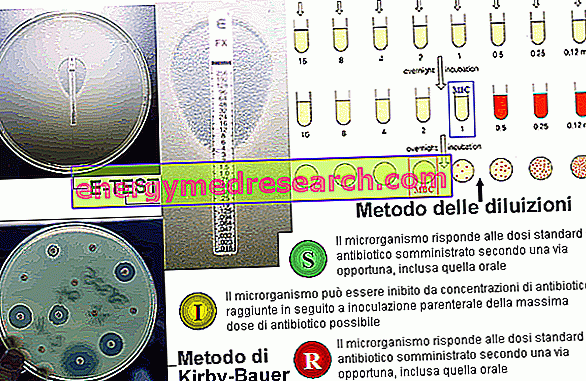What is the antibiogram?
The antibiogram is a microbiological test used to test the sensitivity of a microorganism to one or more antimicrobial drugs.
Exploited mainly on a sanitary level, the antibiogram is traditionally carried out on samples of bacterial colonies derived from units taken by pharyngeal, urethral, rectal or vaginal swab, or isolated from faeces, urine or sputum samples.
Executive techniques and antibiotic resistance
The antibiogram is often performed with the agar-diffusion method, also referred to as the Kirby-Bauer technique.
During the procedure, a bacterial sample is taken from the colonies and sown (appropriately disposed) on the appropriate soil, in which discs soaked in antibiotics at known concentrations (dictated by therapeutic needs) are also distributed. The plate is then placed in an incubator and after a predetermined period of time (eg 18 hours at 35 ° C) it is possible to appreciate a relatively uniform microbial growth, with more or less wide halos around the paper bibs. Based on the extent of these inhibition areas, the susceptibility of the bacterium to each individual antibiotic tested is evaluated: if the diameter is large, the microorganism is sensitive to the drug (S), while if it is small the bacterium has an intermediate sensitivity (I or MS), while if the bacterial species examined is negligible or even absent it is resistant (R) to the medicinal product. To accurately determine the bacterial sensitivity, the diameter of the inhibition halos is measured in mm, comparing the values obtained with the standard values for the bacterial strain.
How to prevent antibiotic resistance
Antibiotics are NOT effective against viruses; Typical viral infections are colds, flu, laryngitis, bronchitis, croup and most sore throats (pharyngitis).
Using antibiotics when they are not needed (for example for colds or flu) can lead to the development of antibiotic resistance (bacteria are "antibiotic-resistant" when they cannot be killed by the antibiotic).
PLEASE NOTE: it is the bacterium that is resistant to the antibiotic, NOT the individual. Therefore, even if you have never used antibiotics, you can develop infections caused by antibiotic-resistant bacteria.
To prevent the emergence of antibiotic resistance it is FUNDAMENTAL to complete the therapy prescribed by the doctor; even if it feels good to stop antibiotics prematurely.
When during the antibiogram the halos of the neighboring discs merge together, the antibiotics in question are considered synergistic.
As an alternative to the method just described, the antibiogram can also be performed on a liquid medium, evaluating - after incubation - the turbidity corresponding to different degrees of drug dilution (see below).
The antibiogram has now become an essential test, given the now widespread diffusion of the drug-resistance phenomenon. Choosing the wrong antibiotic or using a broad-spectrum drug to avoid this procedure can in fact select the bacterial strains resistant to the action of the same. In the article devoted to this topic, we have seen how this capacity was originally acquired for spontaneous mutations, and subsequently transmitted to other bacteria. It is therefore no coincidence that the discovery and clinical use of many antibiotics has gone hand in hand with the appearance of bacteria resistant to their action. Fault, very often, of an inappropriate and exaggerated use of these drugs, for example to cure viral infections against which they prove to be completely useless (the only possible justification is to prevent any bacterial superinfections in people at risk).
Two very important parameters derived from the antibiogram are the MIC and the MBC:
- MIC (Minimum Inhibiting Concentration; minimum inhibitory concentration): it is the lowest concentration of the compound under examination necessary to inhibit the growth of a given microorganism.
- MBC (Minimum Bacterial Concentration): is the lowest concentration of the compound under examination necessary to cause the death of more than 99.9% of a given microbial population.
To assess the MIC in solid media by antibiogram, it is assumed that the microbial agent diffuses from the disk into the agar creating a concentration gradient; consequently, the further away from the disk the lower the concentration of the drug, which progressively decreases to reach the critical concentration (minimum approximate inhibiting concentration MIC). Beyond this point there is confluent growth, while in the area closest to the disk the growth is absent.
In the antibiogram on liquid medium, a series of test tubes containing the culture medium are prepared and scaled dilutions (in the ratio of 2) of the antibiotic to be tested. In each of these tubes a standard quantity of the microbes under examination is inoculated; follows the incubation and examination of the same. As anticipated, in the presence of turbidity bacterial growth is visible, while a solution remained clear denotes complete inhibition of microbial growth, emphasizing the optimal efficacy of the drug. In this case the MIC (minimum inhibitory concentration) represents the highest dilution (ie the lowest concentration) of antibiotic capable of completely inhibiting the growth of the microorganism. The MBC (minimum bactericidal concentration) is instead established by growing the samples taken from the liquid medium in a special solid medium and evaluating the possible bacterial growth. The MIC will therefore correspond to the concentration of antibiotic present in the tube in which the drug is more diluted and which on cultural examination shows no sign of bacterial activity (see figure).

The results of the antibiogram are published in a specific report, where the antibiotics used and the related MMCs are indicated; sometimes the associations of antibiotics that can be used and the degree of resistance of the microorganisms are also listed.
The traditional methods for performing the antibiogram, very useful for educational purposes, are constantly evolving. Today, for example, automated commercial systems are available, while bibula paper pads can be replaced by strips containing incremental doses of antibiotic, suitably indicated on the strip itself (E-test for antibiogram).



